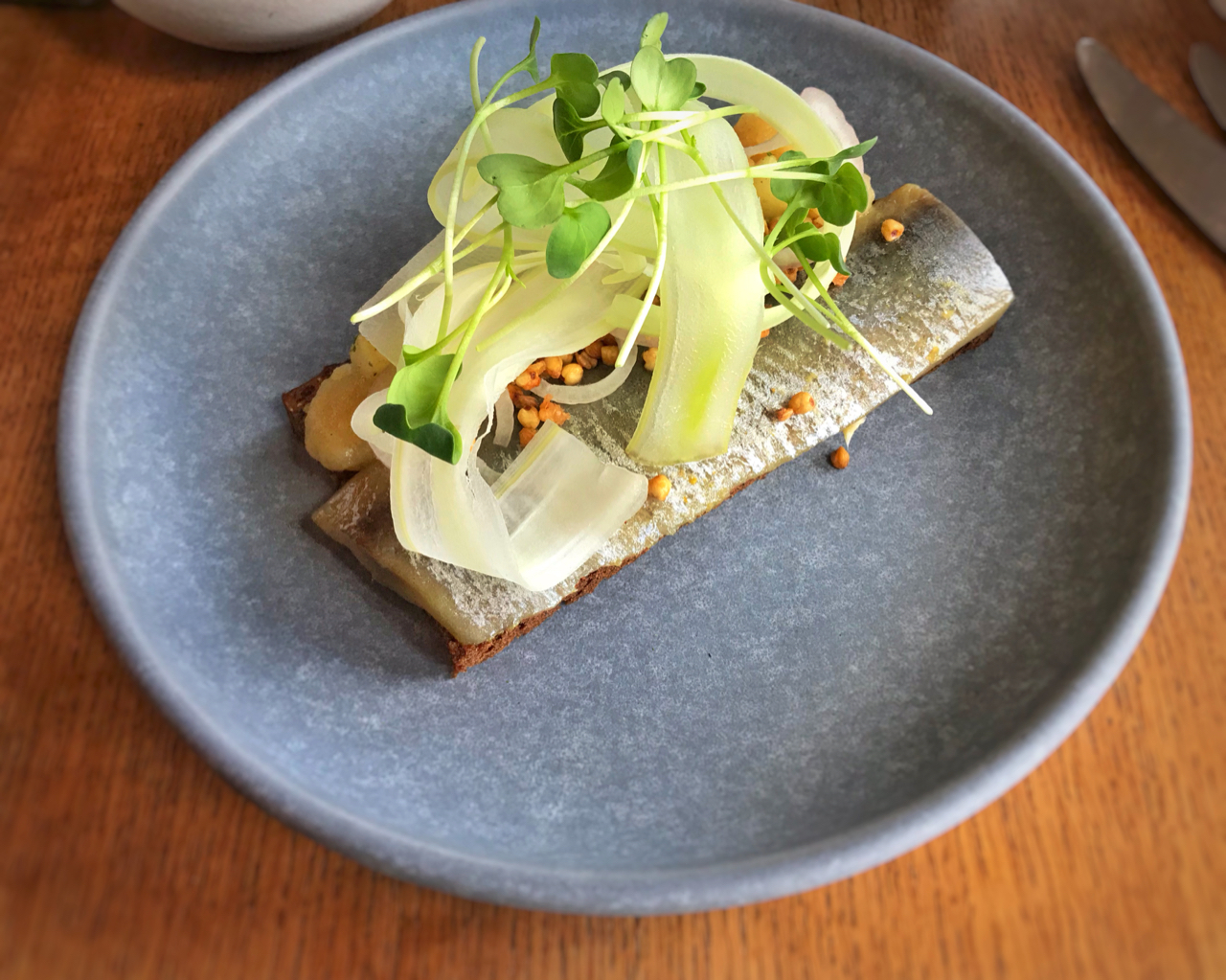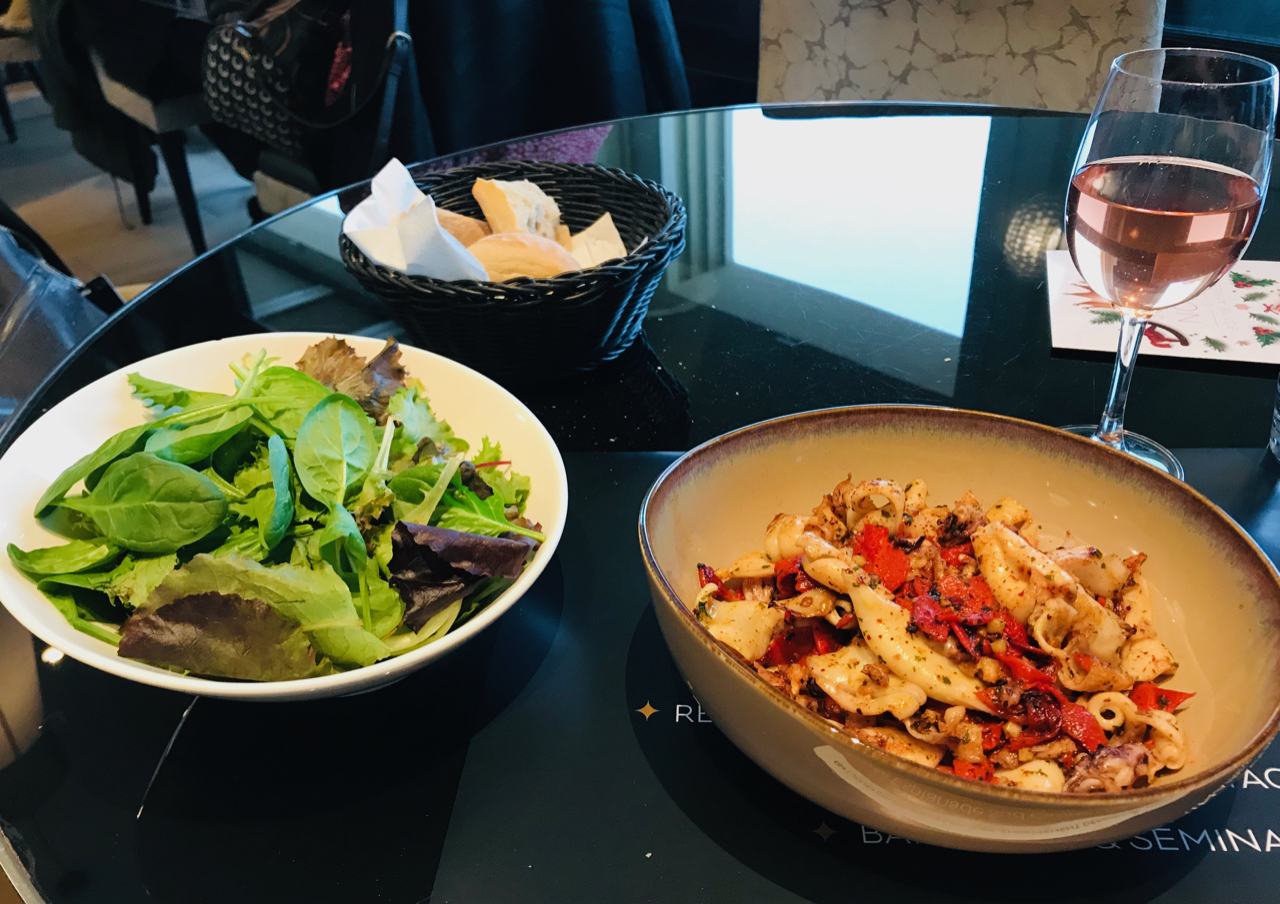 Yesterday I attended the city tour organized by our school, for newcomers. About Spain, in Spanish, of course. I surprised myself by understanding everything – although the guide was a teacher who spoke más despacio.
Yesterday I attended the city tour organized by our school, for newcomers. About Spain, in Spanish, of course. I surprised myself by understanding everything – although the guide was a teacher who spoke más despacio.
Afterwards some of us headed out to Gros in the rain, searching for food. A row of unsuccessful attempts later we concluded that all good places are always full and spilling out into the street even on a Monday. And those that have space have it for a reason. One of the unsuccessful attempts involved us actually getting seated, indoors, in a restaurant that turned out to serve pintxos and bocadillos on its (full) terrace and expensive Italian food in its (empty) restaurant. We gave up, walked out, and entered a busy pintxo bar, signed up for a table promised within half an hour, and attempted to order at the bar.
I and my Dutch classmate got ourselves a glass of wine each without a problem, but deciphering the long list of pintxos calientes and frios and bocadillos was not easy. The stuffed peppers contained meat. The bread with mushrooms contained meat. And meat is never “carne” in Spain but various kinds of cuts and hung and cured pieces of meat, or sausages, all with their own names in Spanish. I quickly concluded that most likely if there is an unfamiliar word on the menu it is the name of a kind of meat.
When we finally got the table I was on my second pintxo. My Dutch classmate had only scored a glass of wine. The rest of our group had not even been that successful: they had been coldly advised to wait until seated before being allowed a drink, let alone food.
The service was the usually slow San Sebastián service. As the rest of the table ate I wistfully meditated on my chances of receiving my third (delicious) anchovy pintxo. I was trying to converse with another Dutch classmate, a barely 20-something young woman, about her internship in the South of Spain. She gushed about how she felt it was her responsibility to also join a civil disobedience movement on climate change. Suddenly the young German (barely 20-something) man next to her poked her on the arm and asked us what we were talking about. “Climate change,” I said. “What do you think about it?” “Ha ha ha,” he nervously laughed, like a comedian. “Do I have to have an opinion about it?” “Well yes,” I said surprised. “Like, do you believe it is happening, or not?” “Ha ha ha” he laughed again, and poked the Dutch woman on the arm once more, provoking her to give him a slap on the head. And that was that conversation.
Also, that was what all conversations turned out to be at our end of the table. A nervous, constantly laughing 20-year-old wooing another pretty much killed all hopes of good talk. I gave up on my anchovy pintxo, put some cash on the table, said good night to everyone, and walked out feeling happy I was old enough to not care about what people thought of me.
As I strolled the streets of Gros I thought how wonderful it once was to have the exciting, dramatic life of a 20-year-old, and how even more wonderful it was to be liberated from expectations and to just be able to exit a situation that did not provide any value.
 (San Sebastián, Spain; August 2019)
(San Sebastián, Spain; August 2019)







 Briefly in Helsinki and a ramen lunch at the original Momo Toko near the University main building is a must. This is where I fed my belly and soul between running Saturday errands in town. Alternatively it was a Vietnamese pho joint – but quite often here in this hot, busy little ramen joint usually crowded with Asians.
Briefly in Helsinki and a ramen lunch at the original Momo Toko near the University main building is a must. This is where I fed my belly and soul between running Saturday errands in town. Alternatively it was a Vietnamese pho joint – but quite often here in this hot, busy little ramen joint usually crowded with Asians. I know I
I know I  (Biarritz, France; November 2019)
(Biarritz, France; November 2019) Every second Sunday a big box arrives on my doorstep. Inside are the ingredients for three days of fresh, vegan, organic, unconventional meals, ready within 10-15 minutes each. Not only are the meals green and fast, they are also interesting: Indian curries, Levantese falafel pitas, and Mediterranean goodness. The salads, dressings and toppings that provide detail are often combinations I have never even thought of.
Every second Sunday a big box arrives on my doorstep. Inside are the ingredients for three days of fresh, vegan, organic, unconventional meals, ready within 10-15 minutes each. Not only are the meals green and fast, they are also interesting: Indian curries, Levantese falafel pitas, and Mediterranean goodness. The salads, dressings and toppings that provide detail are often combinations I have never even thought of. More pintxos. Of course. This is San Sebastián. I lust for fresh vegetables but all I find is pickled olives, pimientos de padrón, or grilled red peppers on bread (which I do love but in moderation!). At home I steam tenderstem broccoli or flat green beans every day. Word is spreading among my classmates about a restaurant that specializes in fresh vegetarian fare. Sounds like heaven to me right now.
More pintxos. Of course. This is San Sebastián. I lust for fresh vegetables but all I find is pickled olives, pimientos de padrón, or grilled red peppers on bread (which I do love but in moderation!). At home I steam tenderstem broccoli or flat green beans every day. Word is spreading among my classmates about a restaurant that specializes in fresh vegetarian fare. Sounds like heaven to me right now.

 Yesterday I attended the city tour organized by our school, for newcomers. About Spain, in Spanish, of course. I surprised myself by understanding everything – although the guide was a teacher who spoke más despacio.
Yesterday I attended the city tour organized by our school, for newcomers. About Spain, in Spanish, of course. I surprised myself by understanding everything – although the guide was a teacher who spoke más despacio. (San Sebastián, Spain; August 2019)
(San Sebastián, Spain; August 2019)